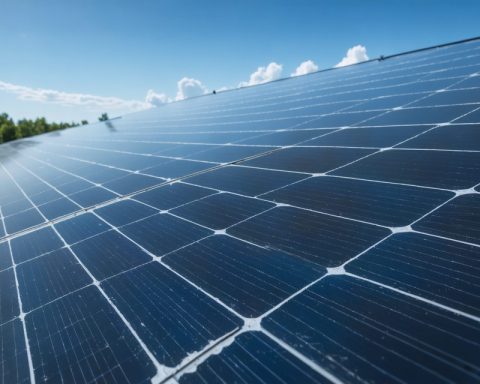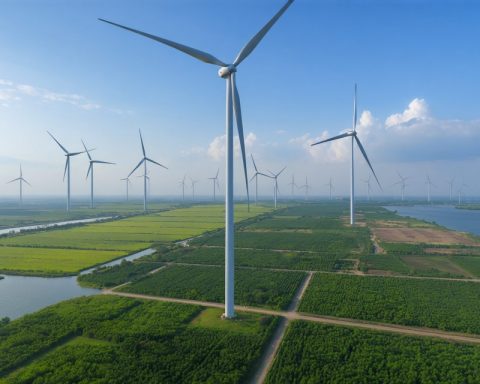- Australia’s Green Energy Systems is collaborating with California on the “Solar Waves” project to cover irrigation canals with solar panels.
- The initiative, part of Project Nexus, aims to generate 12 gigawatts of renewable energy and prevent the evaporation of 238 million liters of water annually.
- The Turlock Irrigation District’s $30 million investment will test a 120-kilowatt deployment, highlighting the cost-effective and durable design by Green Energy Systems.
- The Solar Waves system, integrating panel frames and supports, reduces costs and increases versatility, suitable for land, air, and agrivoltaic applications.
- This project symbolizes a significant stride in using natural resources and advanced technology to promote sustainable energy infrastructure.
In a groundbreaking experiment that could reshape renewable energy infrastructure, Australia’s Green Energy Systems is set to partner with California to deploy its ingenious “Solar Waves” system. This initiative aims to blanket the vast network of Californian irrigation canals with solar panels, igniting a monumental leap toward sustainable energy production.
Imagine California’s sun-soaked canals, transformed into gleaming arteries of solar energy, stretching over 6,437 kilometers. Under the banner of Project Nexus, the vision is to tap into these life-giving waterways, not only to channel water but to generate a staggering 12 gigawatts of renewable energy. Picture enough power surging through these panels to sustain a small country, while concurrently preventing the evaporation of an astounding 238 million liters of precious water each year.
The Turlock Irrigation District’s Innovation Center, bolstered by the tenacity of Solar AquaGRID, spearheads this $30 million endeavor. They have enlisted Green Energy Systems to initiate their trial with a 120-kilowatt deployment. This Australian company isn’t just another contractor; its technology is hailed by project proponents as the most economically viable solution among a field of sixty contenders.
The brilliance of Solar Waves lies in its simplicity and efficiency. Founder Glen Carless, a visionary in sustainable design, engineered a system that operates more like an appliance than a traditional solar installation. This innovative framework fuses the panel frame with its support, halving material costs and eliminating traditional fasteners, thereby achieving unmatched structural integrity. It’s a design made not just for water, but adaptable for land, air, and agrivoltaic applications — talk about versatility!
Imagine a canopy of solar panels elegantly suspended over the canals, their shimmering surfaces reflecting both innovation and endless potential. These prewired, retractable assemblies not only satisfy the demands of solar generation but also adapt seamlessly to the fluctuating requirements of canal maintenance.
What stands out in this ambitious undertaking is the marriage between natural resources and cutting-edge technology — a harmony embodied in Green Energy Systems’ commitment, highlighted by their $20 million investment in research and development. Their partnership with California exemplifies a mutual ambition to pave pathways toward a cleaner, more sustainable future.
As the trial unfolds, it carries a powerful message: by weaving technology, sustainability, and practicality, we can redefine how we energize our world. Let’s envision a future where gleaming solar panels dance over every canal, turning these silent waterways into powerful tributaries of green energy.
How Solar-Powered Canals Could Revolutionize Renewable Energy
Overview of the Solar Waves Innovation
Australia’s Green Energy Systems is embarking on an ambitious project with California to deploy its “Solar Waves” solar panel system over the state’s extensive irrigation canals. This inventive approach aims to convert these canals into both water conduits and solar energy generators, offering a dual advantage by also preventing water evaporation. This initiative, known as Project Nexus, is expected to produce up to 12 gigawatts of renewable energy, while conserving approximately 238 million liters of water annually.
Unveiling Key Additional Facts
1. Environmental Impact and Sustainability
– The Solar Waves project is designed to reduce the carbon footprint associated with energy production. By utilizing existing canal infrastructure, the need for additional land is minimized, preserving natural habitats.
– The reduction in water evaporation also contributes to water conservation efforts, critical in drought-prone regions like California.
2. Market Forecasts and Industry Trends
– According to a report by the International Renewable Energy Agency (IRENA), the global solar energy capacity is expected to reach over 4,000 gigawatts by 2030, driven by innovations like solar canals.
– The U.S. solar market is witnessing a shift toward integrated solutions that combine multiple benefits, such as power generation and resource conservation.
3. Real-World Use Cases
– Similar projects in India have demonstrated that solar canals can decrease water evaporation by up to 50%, showcasing the potential global scalability of this model.
4. Features and Specifications of Solar Waves
– The system’s design eliminates traditional fasteners and reduces material costs by 50%. Glen Carless’s engineering ensures the panels are lightweight yet durable, suitable for varied applications including agrivoltaics.
– The prewired, retractable panels facilitate easy maintenance and adjustments according to seasonal changes.
5. Pros and Cons Overview
– Pros:
– Environmental conservation by reducing land use and water loss.
– Cost-effective production and installation due to innovative design.
– Potential for significant economic benefits through job creation in green tech sectors.
– Cons:
– High initial investment, though reduced over time by operational savings.
– Potential challenges related to long-term maintenance and efficiency losses due to weather conditions.
6. Security and Sustainability
– Solar Waves systems are designed to withstand various environmental conditions, promoting durability. This is crucial for maintaining consistent energy output.
– Leveraging existing canal systems enhances security by integrating into already monitored infrastructure.
Actionable Recommendations
– For Policy Makers: Encourage partnerships and funding for innovative projects like solar canals to accelerate the transition to sustainable energy.
– For Energy Investors: Consider investing in projects that offer dual benefits, such as energy production and resource conservation.
– For Environmental Advocates: Promote awareness about the benefits of solar canals as a model for future sustainable infrastructure projects.
With sustainability at its core, the Solar Waves project paves the way for a new era in renewable energy.
For further information, check out the official California Department of Transportation or Green Energy Systems websites.


















